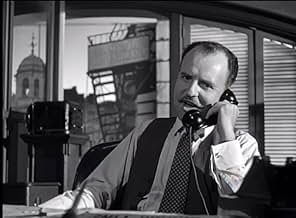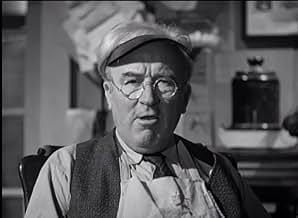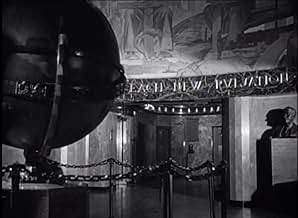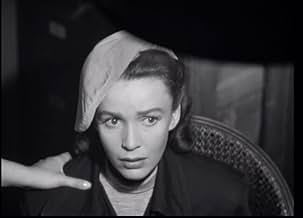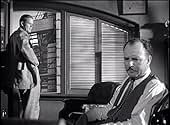VALUTAZIONE IMDb
6,9/10
1450
LA TUA VALUTAZIONE
La storia della lotta di un piccolo giornale cittadino per liberare una ragazza innocente da un'accusa di omicidio.La storia della lotta di un piccolo giornale cittadino per liberare una ragazza innocente da un'accusa di omicidio.La storia della lotta di un piccolo giornale cittadino per liberare una ragazza innocente da un'accusa di omicidio.
- Regia
- Sceneggiatura
- Star
Howard Da Silva
- Carl Durham
- (as Howard da Silva)
Jay Adler
- Munsey's Assistant
- (non citato nei titoli originali)
Recensioni in evidenza
The more I watch classic films, the more I discover what a great year 1950 was in the movie business. Here's another good film, and one many people are probably unfamiliar with. This one revolves around the newspaper business.
Dan Duryea, as usual, is interesting as "Mike Reese," a bad guy-turned-good guy journalist. He is joined in the cast by Herbert Marshall, Gale Storm (one of the great names in show business and who will forever be "My Little Margie" to those of us who were around in the '50s), Howard Da Silva and Michael O'Shea.
Of the above-mentioned, Da Silva was the most fascinating, as the brutal mob boss "Carl Durham." He only had a minor role, but some of his lines were outstanding and his role was memorable. Da Silva was a great actor for film noirs. This isn't really a noir, but it's close. Marshall was just fine as the newspaper owner.
The film was not kind to the newspaper business, so some media-minded film critics (who probably had columns in daily papers) didn't like this film for that reason. Too bad. They should have liked it, since it had Left Wing written all over it, with several Liberal themes and favorite catch-phrases such as "witch hunts" (one of their all-time favorites).
Nonetheless, it's a powerful film and well-acted.
Dan Duryea, as usual, is interesting as "Mike Reese," a bad guy-turned-good guy journalist. He is joined in the cast by Herbert Marshall, Gale Storm (one of the great names in show business and who will forever be "My Little Margie" to those of us who were around in the '50s), Howard Da Silva and Michael O'Shea.
Of the above-mentioned, Da Silva was the most fascinating, as the brutal mob boss "Carl Durham." He only had a minor role, but some of his lines were outstanding and his role was memorable. Da Silva was a great actor for film noirs. This isn't really a noir, but it's close. Marshall was just fine as the newspaper owner.
The film was not kind to the newspaper business, so some media-minded film critics (who probably had columns in daily papers) didn't like this film for that reason. Too bad. They should have liked it, since it had Left Wing written all over it, with several Liberal themes and favorite catch-phrases such as "witch hunts" (one of their all-time favorites).
Nonetheless, it's a powerful film and well-acted.
Deceptively titled, The Underworld Story boasts only tenuous connections to organized crime. It's a newspaper story that centers around a high-profile murder with racial overtones. But its crusading tone and topical allusions never grow strident and don't overwhelm some adroit plotting and incisive character study.
Big-city reporter Dan Duryea finds himself in a jam that makes him persona non grata to his newspaper, the district attorney's office and underworld boss Howard Da Silva. Broke and blacklisted, he buys himself a partial stake in a struggling community paper, The Lakewood Gazette, owned by Gale Storm, who's put off by his brash ways and temporizing ethics. But a headline story breaks right there in the idyllic New England town: The daughter-in-law of press baron Herbert Marshall has been murdered, and Duryea seizes the chance to run with the scoop.
It's not a whodunit, though; the killer, it's clear from the outset, is Marshall's snivelling son (Gar Moore, who sounds like HAL the computer). But when the murdered woman's black maid (Mary Anderson) goes missing, Marshall sees opportunity to whip up public sentiment against her. Storm, who knew the maid, trusts in her innocence; Duryea, on the other hand, waits to see which outcome might profit him most. When The Gazette starts a defense fund for Anderson, Marshall and his son start running scared and seek a favor from Da Silva to put a stop to the tenacious Duryea, who's been won over by Storm....
The Underworld Story's a modest movie that's well put together (it looks great, too, photographed by Stanley Cortez, who also shot The Magnificent Ambersons and Night of the Hunter). But it belongs to Duryea, who could play affable but slithery better than anybody, and his twists and turns keep us guessing.
Reminiscent of 30s socially-conscious cinema more than film noir, The Underworld Story also shows that decade's story-telling verve. It's been purged of preaching, so when one character remarks `Looks like they're burning witches again,' we suddenly recall that its release came in the midst of the Hollywood anti-Communist witch hunt, and that at least two of its principals director Cy Endfield and Da Silva were among its victims.
Big-city reporter Dan Duryea finds himself in a jam that makes him persona non grata to his newspaper, the district attorney's office and underworld boss Howard Da Silva. Broke and blacklisted, he buys himself a partial stake in a struggling community paper, The Lakewood Gazette, owned by Gale Storm, who's put off by his brash ways and temporizing ethics. But a headline story breaks right there in the idyllic New England town: The daughter-in-law of press baron Herbert Marshall has been murdered, and Duryea seizes the chance to run with the scoop.
It's not a whodunit, though; the killer, it's clear from the outset, is Marshall's snivelling son (Gar Moore, who sounds like HAL the computer). But when the murdered woman's black maid (Mary Anderson) goes missing, Marshall sees opportunity to whip up public sentiment against her. Storm, who knew the maid, trusts in her innocence; Duryea, on the other hand, waits to see which outcome might profit him most. When The Gazette starts a defense fund for Anderson, Marshall and his son start running scared and seek a favor from Da Silva to put a stop to the tenacious Duryea, who's been won over by Storm....
The Underworld Story's a modest movie that's well put together (it looks great, too, photographed by Stanley Cortez, who also shot The Magnificent Ambersons and Night of the Hunter). But it belongs to Duryea, who could play affable but slithery better than anybody, and his twists and turns keep us guessing.
Reminiscent of 30s socially-conscious cinema more than film noir, The Underworld Story also shows that decade's story-telling verve. It's been purged of preaching, so when one character remarks `Looks like they're burning witches again,' we suddenly recall that its release came in the midst of the Hollywood anti-Communist witch hunt, and that at least two of its principals director Cy Endfield and Da Silva were among its victims.
Why 'The Underworld Story'? I guess there are some underworld types present but the emphasis is not on the underworld. It's a story about a newspaper editor who has lost his moral compass and moves to the sticks. This is one very few pictures in which Dan Duryeas' name is above the title, and he does an excellent job. Those of us who count him among our favorite character actors will not be disappointed in his star turn here. Complete with sardonic grin and usual wisecracks, he is in his element as the editor-in-search-of-scruples.
It carries the Warner Bros. patina - a gritty crime melodrama with a mix of social commentary and thick-ear rough stuff, and with a curious collection of supporting characters. Howard Da Silva, Gale Storm, Michael O'Shea and Harry Shannon all do themselves credit and Herbert Marshall(?) also manages to fit in.
This is a good semi-noir. It starts off as one but switches in mid-picture to straight drama and then back again. Only 90" long, it holds your interest throughout. It may not sound promising but sometimes you can't judge a movie by its title.
It carries the Warner Bros. patina - a gritty crime melodrama with a mix of social commentary and thick-ear rough stuff, and with a curious collection of supporting characters. Howard Da Silva, Gale Storm, Michael O'Shea and Harry Shannon all do themselves credit and Herbert Marshall(?) also manages to fit in.
This is a good semi-noir. It starts off as one but switches in mid-picture to straight drama and then back again. Only 90" long, it holds your interest throughout. It may not sound promising but sometimes you can't judge a movie by its title.
What makes this little crime movie as effective as it is, has something to do with the casting of unconventional Dan Duryea in the lead as the unscrupulous reporter. He's a lot like Willem Dafoe with the way he talks out of the bottom of his mouth - like a ventriloquist's dummy - and I mean that in a good way. Had they cast a more conventional leading man in the part like a Jimmy Stewart, for example, I don't think it would've worked as well, because Duryea really does come across as quite a heel, a low-life. It just isn't clear to the viewer if he should root for him or not, so that when he does undergo a change in character, it comes as a surprise rather than a foregone conclusion.
The movie also provides Howard Da Silva with one of his last roles before he was to be blacklisted for over 10 years. Always good at playing thugs, he's quite colorful and does a lot of scenery chewing as a powerful crime figure.
The script is intelligent and gritty, and the photography is appropriately stark and oppressive.
The movie also provides Howard Da Silva with one of his last roles before he was to be blacklisted for over 10 years. Always good at playing thugs, he's quite colorful and does a lot of scenery chewing as a powerful crime figure.
The script is intelligent and gritty, and the photography is appropriately stark and oppressive.
Dan Duryea stars as Mike Reese, a big-city newspaperman who is black-balled out of town after publishing a story that helps a mobster rub out an informant. Reese settles in the nearby small town of Lakewood, where he buys a half interest in a newspaper owned by Cathy Harris (Gale Storm). Just as soon as he does, the biggest story to hit Lakewood in decades breaks: the daughter-in-law of E. J. Stanton (Herbert Marshall), the town's wealthiest resident, is found murdered. Reese's experience at bigger papers helps the little operation get the scoop on the out-of-town outfits, but it places Reese and Cathy in the cross-hairs of powers more dangerous than they realize.
A mash-up of newspaper drama, small-town expose, and gangster picture, some of this works, but not a lot. The Reese character is neither helped or hindered by the casting of Duryea: if it was the filmmakers' intention to keep the audience guessing whether or not he was a slime ball at heart or was decent beneath the surface, then Duryea is a good pick, as I still wasn't sure by the end how much of a creep he really was. I say all of this as somebody who is an overall big fan of Dan Duryea. Marshall was awful, turning in an amateur-level performance during his big emotional scenes, although he was never exactly great at that kind of thing. Gale Storm didn't make much of an impression, either. Howard DaSilva has a couple of good scenes as the chief gang boss. This was the final film appearance for Edward Van Sloan, who had been a mainstay in Universal's horror films of the 1930's.
A mash-up of newspaper drama, small-town expose, and gangster picture, some of this works, but not a lot. The Reese character is neither helped or hindered by the casting of Duryea: if it was the filmmakers' intention to keep the audience guessing whether or not he was a slime ball at heart or was decent beneath the surface, then Duryea is a good pick, as I still wasn't sure by the end how much of a creep he really was. I say all of this as somebody who is an overall big fan of Dan Duryea. Marshall was awful, turning in an amateur-level performance during his big emotional scenes, although he was never exactly great at that kind of thing. Gale Storm didn't make much of an impression, either. Howard DaSilva has a couple of good scenes as the chief gang boss. This was the final film appearance for Edward Van Sloan, who had been a mainstay in Universal's horror films of the 1930's.
Lo sapevi?
- QuizThe "N" word is overdubbed with "Negro" on at least two occasions. [Note: this may be a local station's practice; the version shown on TCM contains the uncensored language.]
- BlooperAt the funeral, there is a headstone marked "Robert Elis 1720-1777". After the service, as the mourners are leaving, the same headstone appears in a completely different place.
- Citazioni
District Attorney Ralph Munsey: Take it easy, Reese. Things are tough all over. Pretty soon a man won't be able to sell his own mother.
- Versioni alternativeThe manufacture-on-demand DVD from Warner Archive Collection has the opening and closing 1992 Warner Bros. Pictures logos.
- ConnessioniReferences Bernadette (1943)
I più visti
Accedi per valutare e creare un elenco di titoli salvati per ottenere consigli personalizzati
- How long is The Underworld Story?Powered by Alexa
Dettagli
- Data di uscita
- Paese di origine
- Lingua
- Celebre anche come
- The Underworld Story
- Luoghi delle riprese
- Los Angeles City Hall - 200 North Spring Street, Downtown, Los Angeles, California, Stati Uniti("The Turk" was murdered on the steps of City Hall)
- Azienda produttrice
- Vedi altri crediti dell’azienda su IMDbPro
- Tempo di esecuzione1 ora 31 minuti
- Colore
- Proporzioni
- 1.37 : 1
Contribuisci a questa pagina
Suggerisci una modifica o aggiungi i contenuti mancanti

Divario superiore
What is the Spanish language plot outline for Delitto in prima pagina (1950)?
Rispondi

